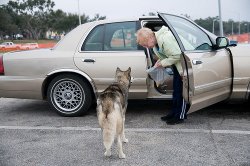What to do if You Find a Lost Pet
July 14, 2009 by LaBecs
Filed under To Rescue or Not: What to do if You Find a Lost Pet
What do you do if you are driving and all of a sudden you see a dog or a cat roaming alone on the street? If you’re an animal lover, I know this is a heart wrenching situation. Do you rescue it or not? If you decide against it… at least call animal control and give the details of where you saw the animal. You will at least be giving it a small chance of getting rescued.
But, put yourself in the original owners place and think what you would want the finder of your animal to do if he found him hurt or without his collar.
 If you’ve never lost a beloved animal you might think that the owner of the found dog or cat abandoned him or neglected to keep him safely confined. But accidents can happen. The frantic owner could be looking everywhere for their pet.
If you’ve never lost a beloved animal you might think that the owner of the found dog or cat abandoned him or neglected to keep him safely confined. But accidents can happen. The frantic owner could be looking everywhere for their pet.
If you decide to rescue it:
Stop for a bit and observe the animal. Does he have a collar? Is he acting scared? Does it look hurt? If you decide that it’s lost, be careful. Not all dogs and cats are friendly, and a hurt animal can be aggressive. Open the back door of your car slowly, as not to startle him or her and call it over… if it comes on its own, great. Don’t try to force it or approach him too fast. Speak softly and try to reassure him. If you’re not able to restrain the animal in a safe way, call the local police or animal control agency.
If you are able to capture him, check for a collar or an ID chip. If you are lucky, he’ll have one and you can call immediately. Otherwise, your first stop should be an animal hospital. They can check for a microchip and find the owners if they find one. If you are planning on taking him or her home, ask the animal hospital to give you flee treatment that you can give right away. If it’s hurt, be ready to take the financial responsibility of his care. If you’ve already made up your mind to take him home, a full vet’s checkup is a good idea, but you have to be willing to pay for it.
That’s the toughest decision: will you take it home or will you take it to the humane society or a shelter? Unfortunately, most animal agencies don’t have the budget to sustain many animals at a time, and most of them euthanize strays in a few days. If you take the animal there, ask for a case number and make sure you leave your information. Make sure to call everyday and see if the owners came forward, otherwise, be ready to take him out before they euthanize him. You can tell them you are taking him home, but it’s important that they know you have the animal, since that is the first place the owners are going to look.
Taking him home will give you a whole new set of responsibilities. You will have to bathe and feed him or her. Be careful with you other animals. You don’t know if this found animal has had all its shots and might put your own pets at risk, so try to keep it separated until you get it checked. Sometimes you can tell by the appearance of the animal if he was lost recently and how well it was taken care off. Is it groomed? Clean? Are his teeth clean? Use your judgment. But remember that if it’s been lost for many days, it won’t look very pretty, so don’t assume it was mistreated or abandoned. The most beloved pets sometimes get out and get lost.
Now it’s time to take pictures. Colored posters work best. Don’t give out every detail of the animal, so you can weed out the real owners. Say it has a collar, but don’t say what color, etc. Post the signs around the area where you found it and a little beyond. Take the poster to different shelters in the area, vet offices, grooming facilities, etc. Use Craigslist! You can post the picture for free. There are many Lost Pet websites where you can register the animal. Call the newspaper. Posting a lost pet announcement is not that expensive. Do you best to find the owners. It can take some time.
Think about what to do while you look for the owners
Can you keep it in your home? Are you willing to return him to his original home if the owner turns up after a while? Can you find him a temporary home until you find the owners? How about a permanent home if you are not lucky in your search?
Check with the ASPCA, the Humane Society and other animal agencies in you area to find out the guidelines about lost and found pets. They can give you more ideas. But all in all, if the animal stays with you while you find its owners, they stand a better chance of surviving. It might be a little costly to be a Good Samaritan, but there are many clinics and agencies that might be willing to help. After all, isn’t it worthwhile to save a life?
What do you do if you are driving and all of a sudden you see a dog or a cat roaming alone on the street? If you’re an animal lover, I know this is a heart wrenching situation. Do you rescue it or not? If you decide against it… at least call animal control and give the details of where you saw the animal. You will at least be giving it a small chance of getting rescued.
But, put yourself in the original owners place and think what you would want the finder of your animal to do if he found him hurt or without his collar.
If you’ve never lost a beloved animal you might think that the owner of the found dog or cat abandoned him or neglected to keep him safely confined. But accidents can happen. The frantic owner could be looking everywhere for their pet.
If you decide to rescue it:
Stop for a bit and observe the animal. Does he have a collar? Is he acting scared? Does it look hurt? If you decide that it’s lost, be careful. Not all dogs and cats are friendly, and a hurt animal can be aggressive. Open the back door of your car slowly, as not to startle him or her and call it over… if it comes on its own, great. Don’t try to force it or approach him too fast. Speak softly and try to reassure him. If you’re not able to restrain the animal in a safe way, call the local police or animal control agency.
If you are able to capture him, check for a collar or an ID chip. If you are lucky, he’ll have one and you can call immediately. Otherwise, your first stop should be an animal hospital. They can check for a microchip and find the owners if they find one. If you are planning on taking him or her home, ask the animal hospital to give you flee treatment that you can give right away. If it’s hurt, be ready to take the financial responsibility of his care. If you’ve already made up your mind to take him home, a full vet’s checkup is a good idea, but you have to be willing to pay for it.
That’s the toughest a decision: will you take it home or will you take it to the humane society or a shelter? Unfortunately, most animal agencies don’t have the budget to sustain many animals at a time, and most of them euthanize strays in a few days. If you take the animal there, ask for a case number and make sure you leave your information. Make sure to call everyday and see if the owners came forward, otherwise, be ready to take him out before they euthanize him. You can tell them you are taking him home, but it’s important that they know you have the animal, since that is the first place the owners are going to look.
Taking him home will give you a whole new set of responsibilities. You will have to bathe and feed him or her. Be careful with you other animals. You don’t know if this found animal has had all its shots and might put your own pets at risk, so try to keep it separated until you get it checked. Sometimes you can tell by the appearance of the animal if he was lost recently and how well it was taken care off. Is it groomed? Clean? Are his teeth clean? Use your judgment. But remember that if it’s been lost for many days, it won’t look very pretty, so don’t assume it was mistreated or abandoned. The most beloved pets sometimes get out and get lost.
Now it’s time to take pictures. Colored posters work best. Don’t give out every detail of the animal, so you can weed out the real owners. Say it has a collar, but don’t say what color, etc. Post the signs around the area where you found it and a little beyond. Take the poster to different shelters in the area, vet offices, grooming facilities, etc. Use Craigslist! You can post the picture for free. There are many Lost Pet websites where you can register the animal. Call the newspaper. Posting a lost pet announcement is not that expensive. Do you best to find the owners. It can take some time.
Think about what to do while you look for the owners
Can you keep it in your home? Are you willing to return him to his original home if the owner turns up after a while? Can you find him a temporary home until you find the owners? How about a permanent home if you are not lucky in your search?
Check with the ASPCA, the Humane Society and other animal agencies in you area to find out the guidelines about lost and found pets. They can give you more ideas. But all in all, if the animal stays with you while you find its owners, they stand a better chance of surviving. It might be a little costly to be a Good Samaritan, but there are many clinics and agencies that might be willing to help. After all, isn’t it worthwhile to save a life?
Photo Courtesy of:
Neutering or Spaying Your New Dog
March 24, 2009 by LaBecs
Filed under Neutering or Spaying Your New Dog
If you are having doubts about neutering or spaying your new dog, you have to consider the benefits for his or her health and for both your lives.
Male dogs are not “manly” and female dogs do not “need” to have puppies.
There are people (usually men… no offense, guys) that actually think that keeping their dog’s testicles intact is manly, both for the dog and for the owner… sometimes, people go as far as to have prosthetic testicles inserted for their neutered dogs. To each it’s own, but… really?
Also, breeding a dog is not necessarily better for the animal, neither male nor female, and it certainly can make dogs much more difficult to manage if they are not neutered.
Unless there is a specific reason to breed your dog, it should be neutered or spayed at an early age to prevent pregnancies, avoid aggressive male behavior, and even lessening the possibilities of some forms of cancer.
It’s normally recommended that the dog gets neutered between 2 and 6 months old. Of course, there is always a small risk associated with any sort of surgery, but it’s riskier to own a dog with an aggressive sex drive. Another reason to do it early, is that younger pups manage through the surgery option much better than older dogs. The surgery is very simple and can be performed in a matter of minutes.
Now, let’s clarify some myths:
Early neutering or spaying does not stunt growth. That’s a myth propagated by breeders and others who don’t want to spay their animals.
Your dog will not get fat and lazy after being spayed or neutered unless you feed him/her too much.
What happens if your male dog is not neutered?
-They will pee on everything they find on their way: furniture, curtains, shoes, clothes, walls… you get the idea.
-Dogs might be aggressive to other dogs and also hump even other male dogs. Just this fact should give you an idea of what kind of aggression can develop in those circumstances, besides, it’s very embarrassing.
-Even dogs that normally have the most wonderful temperament, can get aggressive towards humans and other dogs. A male will actually attempt to kill any male who he thinks will mate a bitch near him.
Don’t be kind to your dog by “letting try it out at least once”. Once a dog has actually had sex, his behavior can be magnified significantly when coming in contact with fertile bitches.
When a male dog is after a fertile female, breeding is the only thing on his mind. He will do anything that he can think of to get to her: scaling fences, breaking down doors, mating through fences, digging, etc. Besides risking getting sued for any damage, another thing to consider is that you are as responsible as the owner of the female for any puppies that are born.
What happens if your female dog is not spayed?

Rovespierre
-First, you can count on having her locked up twice a year to keep her away from all those dogs that I mentioned before.
-Her risk of mammary cancer doubles, although it doubles from almost nothing to very low with only one heat, it climbs quickly thereafter till after 5 heats as it starts to approach 50%. Be very careful that you don’t allow a mating when she gets her first heat because this can be life threatening. It is very important to spay her before the first heat.
-A brother and sister from the same litter can create their own litters by the age of five months. It is not a good idea to allow this to happen.
-Male dogs can sometimes be quite aggressive to a female in season.
-Your house will be a mess, and her behavior will drive you crazy.
After reading all this, you need to ask yourself, “is it really worth it?”
Frankly, in the 99.99% of cases, it is not.
Don’t wait until your dog starts getting sexual drives before you neuter him. In many cases, once the dog starts the misbehavior associated with attempting to breed, that behavior can stay even after the neutering has taken place.
Do yourself, your family, your neighbors and your beloved dogs a favor by getting them spayed and neutered.


